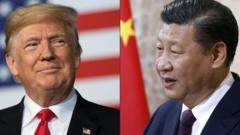As US-China trade tensions escalate, both nations appear hesitant to initiate formal negotiations, each aiming to outmaneuver the other while saving face. Experts suggest that undefined diplomacy could be a pathway to de-escalation, but both leaders face domestic pressures complicating the situation.
Stalemate Continues: Will US-China Trade Talks Emerge from the Shadows?

Stalemate Continues: Will US-China Trade Talks Emerge from the Shadows?
A game of diplomatic chicken unfolds between the US and China as both powers navigate the tumultuous waters of a spiraling trade war, raising the stakes for talks to relieve tariffs.
Despite the escalated tariffs imposed on Chinese exports reaching as high as 245%, a spokesperson from China's Ministry of Commerce announced on Friday their consideration of tariff negotiations with the United States. This announcement has been met with cautious optimism globally, as the ongoing trade war looms, raising fears of a potential recession for both countries. According to the spokesperson, "If the US wants to talk, it should show its sincerity and be prepared to correct its wrong practices and cancel unilateral tariffs."
The complex dynamics were underlined by earlier contradictory statements, with some Chinese state media suggesting that the US was probing for dialogue, while President Trump claimed discussions were already occurring—a claim that was met with denial from Beijing. A Weibo account affiliated with state media, Yuyuantantian, claimed, "China has no need to talk to the United States," stressing that the US appeared more anxious.
This scenario resembles a high-stakes game of chicken between President Trump and President Xi Jinping, with both leaders focused on maintaining their public images while potentially seeking a resolution. Political analysts, such as Ja Ian Chong from the National University of Singapore, recognize the ongoing back-and-forth but see little impetus from either side to appear as yielding. "Neither Washington nor Beijing wants to look like they are the side that's giving in," he explained, emphasizing that while de-escalation is beneficial, the leaders are stuck in a complicated narrative.
Wen-Ti Sung from the Australian Centre on China in the World further elaborated on the nature of the stalemate, stating, "It's like two race cars going at each other: whoever swerves first will be seen as the weaker of the two parties." This predicament fosters a notion of "constructive ambiguity," where vague language allows both parties to assert they remain justified in their stances.
One potential avenue for breaking this impasse could involve third-party mediation, or even an informal understanding that could give both leaders a basis to initiate talks while claiming they were not the first to do so. The leaders desire to present themselves as victorious to their respective domestic audiences, with Trump aiming to showcase a capitulation from Beijing, and Xi wanting to emerge with a narrative of having made Trump more amenable.
Domestically, both leaders face challenges exacerbated by tariffs. Trump is contending with fears of economic contraction, while Xi is addressing issues of low consumption and rising unemployment within China. Sung notes that both parties comprehend the evolution of the trade war, recognizing it will not favor a single victor; thus, they are searching for compromise positions.
While communication appears to be established between the two nations at a foundational level, there remains uncertainty around whether substantial dialogue will materialize. Chong emphasizes, “For now, they will continue to gauge which side will yield first in this complex negotiation landscape.” The prospect of meaningful negotiations seems contingent upon both parties finding a satisfactory middle ground that satisfies their respective narratives and political pressures.
The complex dynamics were underlined by earlier contradictory statements, with some Chinese state media suggesting that the US was probing for dialogue, while President Trump claimed discussions were already occurring—a claim that was met with denial from Beijing. A Weibo account affiliated with state media, Yuyuantantian, claimed, "China has no need to talk to the United States," stressing that the US appeared more anxious.
This scenario resembles a high-stakes game of chicken between President Trump and President Xi Jinping, with both leaders focused on maintaining their public images while potentially seeking a resolution. Political analysts, such as Ja Ian Chong from the National University of Singapore, recognize the ongoing back-and-forth but see little impetus from either side to appear as yielding. "Neither Washington nor Beijing wants to look like they are the side that's giving in," he explained, emphasizing that while de-escalation is beneficial, the leaders are stuck in a complicated narrative.
Wen-Ti Sung from the Australian Centre on China in the World further elaborated on the nature of the stalemate, stating, "It's like two race cars going at each other: whoever swerves first will be seen as the weaker of the two parties." This predicament fosters a notion of "constructive ambiguity," where vague language allows both parties to assert they remain justified in their stances.
One potential avenue for breaking this impasse could involve third-party mediation, or even an informal understanding that could give both leaders a basis to initiate talks while claiming they were not the first to do so. The leaders desire to present themselves as victorious to their respective domestic audiences, with Trump aiming to showcase a capitulation from Beijing, and Xi wanting to emerge with a narrative of having made Trump more amenable.
Domestically, both leaders face challenges exacerbated by tariffs. Trump is contending with fears of economic contraction, while Xi is addressing issues of low consumption and rising unemployment within China. Sung notes that both parties comprehend the evolution of the trade war, recognizing it will not favor a single victor; thus, they are searching for compromise positions.
While communication appears to be established between the two nations at a foundational level, there remains uncertainty around whether substantial dialogue will materialize. Chong emphasizes, “For now, they will continue to gauge which side will yield first in this complex negotiation landscape.” The prospect of meaningful negotiations seems contingent upon both parties finding a satisfactory middle ground that satisfies their respective narratives and political pressures.


















